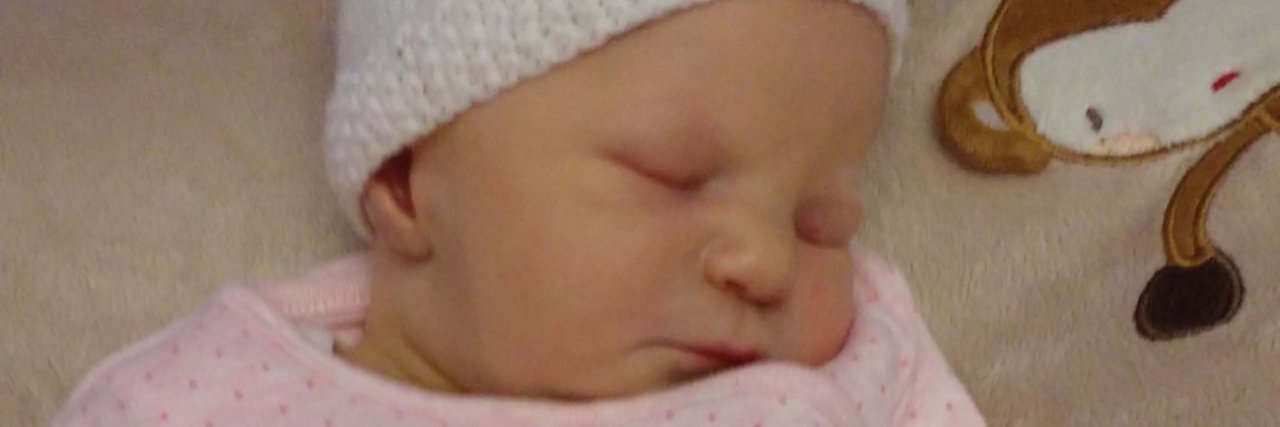How We Went From Sadness to Hope After Our Child's Rare Diagnosis
Imogen is our second child — our beautiful much longed-for daughter to complete our family. She came into the world on September 26th, a week early, and weighing in at just 6 pounds and 5.5 ounces. She was tiny, particularly considering her older brother was 9 pounds and 15 ounces. We expected her to be even bigger.
In the theatre during the C-section, through the haze of the spinal block that made the ceiling above me spin, I knew straight away something wasn’t right. She seemed too tiny as they whisked her away to administer oxygen. Her size, along with a surprise addition of an extra digit on each hand and foot, a list of minor problems at her newborn examination (slight heart murmur, click-y hips, sacral dimple) and the fact she refused to open her eyes at all for close to a week following her birth, all added up to a sense of unease that was only placated slightly by the pediatricians reassuring us that she did not look “syndromic.” In all likely hood, they said they were all coincidental, minor problems that were fixable. A genetic test was organized to reassure us, and we took our baby home and tried to celebrate her arrival as best we could and push the sense of doom away.
At 18 days old we attended her cardiology exam for the heart murmur she had at birth. It was here the kind, softly spoken pediatrician told us the genetic results had come back earlier than expected, and instead of leaving us to wait for the genetics appointment two months later, he had agreed to give them to us now. The news was not good. Imogen was missing a part of a chromosome; it would mean almost certain developmental delays. She would meet all her milestones late, have moderate to severe learning difficulties, be small in stature and have slow growth, have possible heart and kidney problems (luckily she has neither) and a 1 in 3 chance of epilepsy (which confirmed the jerk movements we had been witnessing as seizures). It also explained her eyes not opening well (ptosis), her extra digits (polydactyly) and her sacral dimple. Had I come across a list of all its features on the internet in my searches, I would have recognized it immediately, but of course with its rarity (only 50 cases documented in the last 30 years) we had not come encountered it.
I asked the pediatrician if her condition had a name, and he replied, “Yes, well it has numbers and letters – 3p25 deletion syndrome.”
My 3-year-old son Felix, with his perfect sense of timing brought us back into the real world by announcing he needed the toilet and my husband took him. I let the doctor know the fear, grief and deep sadness I felt. He looked sympathetic, saying he understood. He finished the appointment, reminding us she was still our beautiful daughter, and we left with the only information he could give us: a PDF print out on 3p25 deletion from a wonderful charity called Unique.
We sat in the waiting room and read the PDF from start to finish and cried. Along with all the immediate diagnoses came a possibility of some pretty terrifying diseases in her future. Her deletion is a big one, and the 10.7mb of chromosome she is missing take with them 99 genes. We came home and cried some more.
Our world felt like it had fallen apart in a way we had never imagined.
I’m sad to say I didn’t handle it well. I wish I could say I took it in my stride, but I didn’t. I broke down. I stopped eating, couldn’t see my friends, cried more then I knew possible and started having panic attacks on waking every morning. My brain was constantly searching for a solution. I wondered if life would ever be OK again for my daughter. But five months on, I can definitely say it’s getting better. It’s still tough. It still hurts more then anything I’ve ever felt before, and if I had the chance I would give anything to take away the difficulties Imogen will face in life away from her. But Imogen keeps providing us with hope and we are getting to know the little girl that she is. We focus now on giving her the therapies, experiences, and love she needs to be the absolute best she can be.
In her short life so far, she has been through two hospital admissions, two EEGs, one MRI, two plastic surgeries, ultrasounds of every major organ, as well as the spine and hip, and numerous blood tests. Imogen has seen more pediatricians than I care to count, and has a physiotherapist, speech therapist, dietitian and occupational therapist. It’s quite the entourage. In short, she has encountered more of the NHS than most adults I know.
Imogen is so much more than her medical challenges. She has learned to smile, laugh, and track objects with her eyes and reach for things. She can lift up her head during tummy time and grab her feet during nappy changes. She reacts to songs like “Wind the Bobbin Up” and “Round and Round the Garden,” loves her bath, and likes to cuddle a muslin while she sleeps. She’s her own little person and she’s exactly who she is meant to be. She has also won the hearts of countless friends and family. She has a pretty big fan club for such a little girl. We are determined to help her learn to do everything she can — it will just be in Imogen’s own time.
Follow this journey on A Rare Kind of Normal

